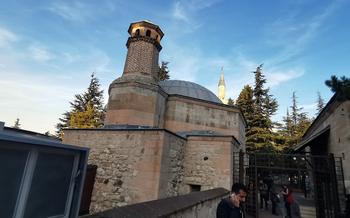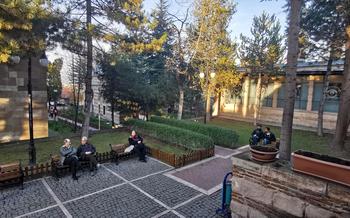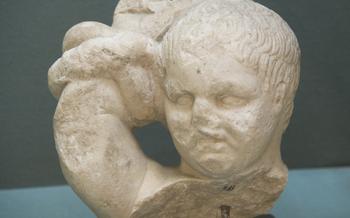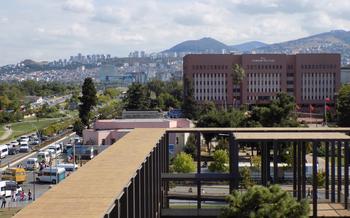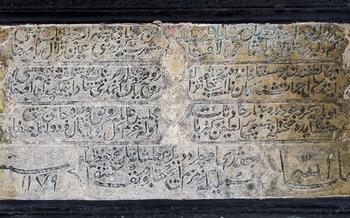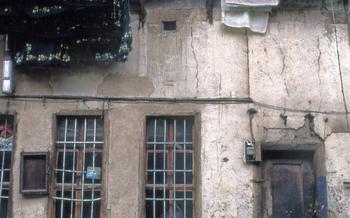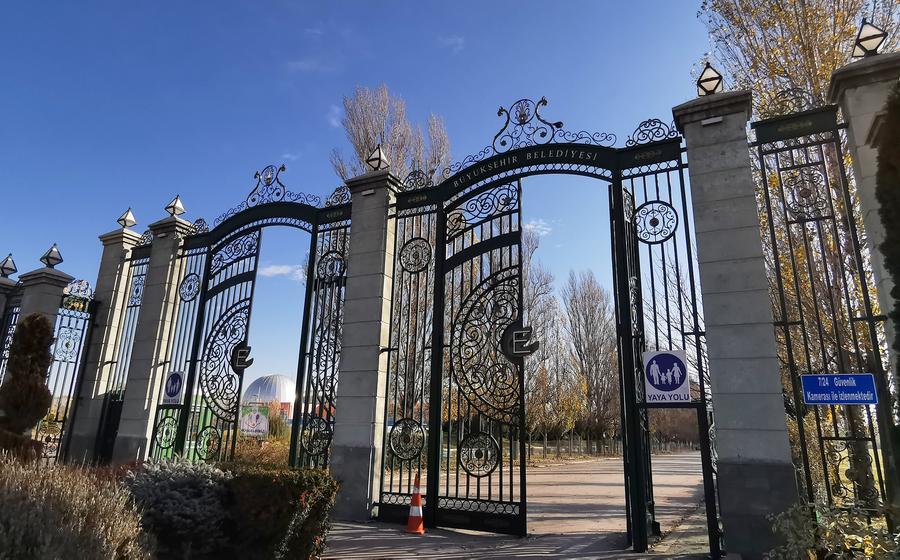
Archeological Museum
- Historical Background
- Location and Accessibility
- Museum Collections
- Phrygian Artifacts: Unveiling the Ancient Anatolian Civilization
- Roman Artifacts
- Ottoman Artifacts
- Interactive Exhibits
- Research and Conservation
- Educational Programs: Fostering Cultural Awareness and Appreciation for History
- Accessibility and Inclusivity
- Visitor Services
- Photography and Social Media
- Upcoming Events and Exhibitions
- Insider Tip:
Historical Background
Eskişehir, a city nestled in the heart of Anatolia, boasts a rich and diverse history that spans several civilizations. The Archaeological Museum, a treasure trove of historical artifacts, invites visitors to embark on a journey through time, exploring the region's ancient past.
Established in 1997, the museum stands as a testament to the city's commitment to preserving and showcasing its cultural heritage. Its collection of artifacts, meticulously curated and displayed, offers a glimpse into the lives and traditions of the many civilizations that have called Eskişehir home.
From the enigmatic Phrygians, who left behind intricate sculptures and pottery, to the Romans, whose influence is evident in the well-preserved mosaics and inscriptions, and the Ottomans, whose legacy is reflected in the exquisite ceramics and textiles, the museum's exhibits paint a vivid picture of Eskişehir's vibrant past.
Location and Accessibility
The Eskişehir Archaeological Museum is strategically situated in the heart of the city, at Kurtuluş Mahallesi, Dumlupınar Bulvarı No:40. Visitors can conveniently reach the museum using public transportation, as it is well-connected by bus lines from various parts of the city. Alternatively, private vehicles can be parked in the designated parking area adjacent to the museum.
The museum's proximity to other popular attractions in Eskişehir makes it an ideal starting point for exploring the city's rich cultural heritage. Within walking distance, visitors can discover the enchanting Porsuk River, lined with historical bridges and serene parks, as well as the vibrant Odunpazarı district, renowned for its restored Ottoman architecture and traditional handicrafts.
For a comprehensive and immersive experience, guided tours are available upon request, providing visitors with valuable insights into the museum's collection and the captivating history of Eskişehir. The museum also offers a range of facilities to enhance visitor comfort, including a cloakroom for menyimpan barang bawaan, a gift shop for purchasing souvenirs, and a café for refreshments.
Museum Collections
The Eskişehir Archaeological Museum houses a diverse collection of artifacts that provide a comprehensive overview of the city's rich history. The exhibits are arranged chronologically, showcasing the development of Eskişehir from the Phrygian period to the Ottoman era. Among the highlights of the collection are the Phrygian sculptures, which depict various deities, animals, and mythical creatures. These sculptures offer a glimpse into the religious beliefs and artistic traditions of the Phrygians.
The museum also displays a remarkable collection of Roman mosaics, which depict scenes from mythology, everyday life, and nature. These mosaics are evidence of the Roman Empire's influence on Eskişehir and the region. Visitors can admire the intricate craftsmanship and vivid colors of these mosaics, which have been preserved in excellent condition.
The Ottoman section of the museum features a collection of ceramics, textiles, and manuscripts that showcase the artistic and cultural achievements of the Ottoman Empire. These artifacts include stunning examples of Islamic calligraphy, intricate tilework, and ornate metalwork. Visitors can learn about the Ottoman Empire's contributions to Eskişehir's cultural heritage and the lasting impact of its rule on the city.
Phrygian Artifacts: Unveiling the Ancient Anatolian Civilization
The Archaeological Museum of Eskişehir houses a remarkable collection of Phrygian artifacts, offering a glimpse into the lives and culture of one of Anatolia's earliest civilizations. The Phrygians, who flourished in the region during the 12th to 7th centuries BC, left behind a rich legacy of art and craftsmanship that continues to captivate visitors to the museum.
Among the most notable Phrygian artifacts are the intricately carved stone sculptures, which depict a variety of subjects, including gods, goddesses, animals, and mythical creatures. These sculptures showcase the Phrygians' unique artistic style, which often combined realistic and abstract elements. The Phrygian potters also demonstrated exceptional skill, creating finely decorated ceramics that ranged from simple bowls to elaborate vessels with intricate patterns.
Jewelry was another important aspect of Phrygian culture, and the museum's collection includes a variety of gold, silver, and bronze pieces. These ornaments, which often featured intricate filigree work and colorful gemstones, were worn by men and women to display their wealth and status.
The Phrygian artifacts at the Eskişehir Archaeological Museum provide valuable insights into the daily life, religious beliefs, and artistic traditions of this ancient civilization. Ongoing research and excavations continue to shed light on the Phrygian culture, adding to our understanding of this fascinating period in Anatolian history.
Roman Artifacts
The Archaeological Museum in Eskişehir boasts a remarkable collection of Roman artifacts that provide a glimpse into the city's rich history under the Roman Empire. Among these artifacts are beautifully preserved mosaics, intricately designed coins, and inscriptions that shed light on the Roman influence in the region.
The mosaics, with their vibrant colors and intricate patterns, depict scenes from Roman mythology, daily life, and religious practices. These stunning artworks offer visitors a glimpse into the artistic traditions of the Roman period and provide valuable insights into the beliefs and values of the Roman people.
The museum also houses a collection of Roman coins that showcase the Empire's monetary system and economic prowess. These coins feature the effigies of Roman emperors, deities, and symbols of power, offering a tangible connection to the political and economic history of the Roman Empire.
Furthermore, the museum's collection of Roman inscriptions provides valuable historical information. These inscriptions, which include epitaphs, dedications, and official documents, offer insights into the lives of ordinary Romans, their social customs, and their interactions with the imperial administration.
Overall, the Roman artifacts at the Eskişehir Archaeological Museum offer a fascinating glimpse into the city's past under Roman rule and provide a deeper understanding of the Empire's enduring legacy in the region.
Ottoman Artifacts
The Archaeological Museum in Eskişehir boasts a remarkable collection of Ottoman artifacts that provide a glimpse into the rich cultural heritage of the Ottoman Empire in the region. These artifacts, which include intricate ceramics, finely woven textiles, and beautifully illuminated manuscripts, showcase the empire's artistic prowess and its blending of Islamic and Anatolian traditions.
Among the highlights of the Ottoman collection are exquisite examples of Kütahya ceramics, renowned for their vibrant colors and intricate patterns. These ceramics, which were crafted by skilled artisans in the city of Kütahya, were highly prized by the Ottoman elite and adorned the palaces and mansions of the empire.
The museum also houses a collection of Ottoman textiles that showcase the empire's mastery of weaving and embroidery. These textiles, which include carpets, kilims, and garments, feature intricate designs and vibrant colors, reflecting the nomadic heritage of the Ottoman Turks and their appreciation for fine craftsmanship.
In addition, the museum's collection of Ottoman manuscripts offers a glimpse into the intellectual and literary achievements of the empire. These manuscripts, which include Qur'ans, historical texts, and works of poetry, are adorned with intricate calligraphy and illuminated with vibrant colors, demonstrating the empire's commitment to Islamic art and scholarship.
These Ottoman artifacts not only provide a fascinating glimpse into the empire's cultural heritage but also serve as a testament to the enduring legacy of the Ottoman Empire in Eskişehir and the surrounding region.
Interactive Exhibits
The Eskişehir Archaeological Museum offers a variety of interactive exhibits and educational programs that engage visitors and enhance their understanding of the city's history. These exhibits utilize modern technology and hands-on activities to make learning fun and accessible for people of all ages.
One popular interactive exhibit is a 3D virtual tour of ancient Eskişehir. Visitors can explore the city's iconic landmarks and historical sites using virtual reality headsets, immersing themselves in the past and experiencing the city as it once was.
Another interactive exhibit allows visitors to handle replicas of ancient artifacts and try their hand at deciphering cuneiform inscriptions or creating their own pottery. These hands-on experiences provide a deeper understanding of the skills and craftsmanship of ancient civilizations.
The museum also offers educational programs for students and families, including guided tours, workshops, and lectures. These programs aim to foster cultural awareness and appreciation for history, inspiring the next generation of archaeologists and historians.
By incorporating interactive elements and educational programs, the Eskişehir Archaeological Museum creates a dynamic and engaging learning environment that brings the city's rich past to life.
Research and Conservation
The Archaeological Museum of Eskişehir is not merely a repository of ancient artifacts; it is also an active hub of archaeological research and conservation. The museum's dedicated team of curators, archaeologists, and conservators work tirelessly to uncover new insights into Eskişehir's rich past and to preserve its cultural heritage for future generations.
Research plays a crucial role in understanding and interpreting the artifacts housed within the museum. Through meticulous excavation, analysis, and study, the museum's researchers strive to unravel the stories behind these objects and shed light on the lives of those who created and used them. Their work extends beyond the museum walls, as they collaborate with other institutions and universities to conduct joint research projects and contribute to the broader field of archaeological knowledge.
Equally important is the museum's commitment to conservation. Artifacts, as precious as they are, are susceptible to the ravages of time and environmental factors. The museum's conservators employ state-of-the-art techniques and materials to stabilize, restore, and preserve these delicate relics. Their painstaking efforts ensure that future generations can continue to appreciate and learn from these tangible fragments of the past.
Through its dedication to research and conservation, the Archaeological Museum of Eskişehir plays a vital role in safeguarding and interpreting the region's cultural heritage. It serves as a bridge between the past and the present, connecting us with the lives, cultures, and achievements of those who came before us.
Educational Programs: Fostering Cultural Awareness and Appreciation for History
The Archaeological Museum in Eskişehir recognizes the importance of education in fostering cultural awareness and appreciation for history. To this end, the museum offers a diverse range of educational programs tailored to students, families, and the general public. These programs aim to engage visitors of all ages and backgrounds, providing them with opportunities to learn about and explore the rich cultural heritage of Eskişehir.
Guided tours led by knowledgeable museum educators are a popular way to delve deeper into the museum's collection. These tours offer insights into the historical context, significance, and symbolism of the artifacts, bringing the past to life for visitors. The museum also organizes workshops and lectures on various topics related to archaeology and history. These events provide a platform for experts to share their knowledge and research with the public, fostering a deeper understanding of the region's cultural heritage.
Families with children can enjoy interactive educational programs designed to spark their curiosity and imagination. These programs may include hands-on activities, storytelling sessions, or treasure hunts, making learning about history fun and engaging for young minds. The museum also collaborates with local schools to offer educational programs that complement classroom studies, providing students with an immersive learning experience outside the traditional classroom setting.
By offering these educational programs, the Archaeological Museum in Eskişehir plays a vital role in promoting cultural awareness and appreciation for history among the local community and visitors alike. These programs contribute to a deeper understanding of the region's rich past and help preserve its cultural heritage for future generations.
Accessibility and Inclusivity
The Archaeological Museum of Eskişehir is committed to providing an inclusive and accessible experience for all visitors. The museum has ramps and elevators to ensure that visitors with disabilities can easily navigate the exhibits. Audio guides are also available in multiple languages to assist visitors who may have difficulty reading the exhibits. The museum staff is dedicated to creating a welcoming and supportive environment for all visitors and is happy to provide assistance or answer any questions. The museum also offers a variety of educational programs and workshops that are designed to be inclusive and accessible to people of all ages and abilities.
Visitor Services
The Archaeological Museum of Eskişehir offers a range of visitor services to enhance the museum experience. A gift shop is located within the museum, providing a curated selection of souvenirs, books, and replicas of artifacts. Visitors can take a break and enjoy a refreshing beverage or a light snack at the museum's café, offering a menu of local specialties and international favorites. A cloakroom is available for visitors to store their belongings securely while exploring the museum's exhibits. The museum staff is dedicated to providing a welcoming and supportive environment, offering assistance and guidance to visitors throughout their visit. Guided tours in different languages can be arranged upon request, ensuring that visitors from diverse backgrounds can fully appreciate the museum's collections and stories.
Photography and Social Media
The Archaeological Museum of Eskişehir encourages visitors to capture and share their experiences through photography and social media. Visitors are welcome to take photos and videos for personal use, but the use of flash or tripods may be restricted in certain areas to protect the artifacts. To ensure a respectful and enjoyable environment for all visitors, it is important to follow the museum's guidelines and refrain from disturbing other visitors or blocking exhibits while taking photos or videos.
Visitors are encouraged to share their experiences and photos on social media using the designated hashtags #EskişehirArchaeologicalMuseum or #EskişehirMuseum. The museum actively engages with visitors online through its social media channels, sharing behind-the-scenes glimpses, interesting facts, and announcements about upcoming events and exhibitions. By sharing your photos and experiences, you can contribute to the museum's online community and connect with fellow history enthusiasts from around the world.
Upcoming Events and Exhibitions
To make the most of your visit to the Archaeological Museum in Eskişehir, it's essential to stay updated on the museum's calendar of events and exhibitions. The museum regularly organizes a variety of programs and activities for visitors of all ages and interests. From lectures and workshops to concerts and temporary exhibits, there's always something new and exciting happening at the museum.
Keep an eye out for special events or festivals that may be held in conjunction with the museum. These events often feature unique exhibitions, performances, or hands-on activities that allow visitors to delve deeper into Eskişehir's rich history and culture.
One upcoming event that you might want to consider attending is the annual "Archaeological Days" festival. This festival celebrates the museum's anniversary with a series of special exhibitions, guided tours, and educational programs. It's an excellent opportunity to learn more about Eskişehir's archaeological heritage and see some of the museum's most prized artifacts up close.
For the most up-to-date information on upcoming events and exhibitions, be sure to check the museum's website or social media pages. With so much to offer, there's something for everyone at the Archaeological Museum in Eskişehir!
Insider Tip:
As a seasoned traveler, I highly recommend visiting the Archaeological Museum early in the morning. Not only will you beat the crowds, but you'll also have the chance to immerse yourself in the museum's tranquil atmosphere. Take your time exploring the exhibits, and don't forget to admire the intricate details of the Phrygian sculptures. If you're lucky, you might even catch a glimpse of the museum's resident cat, who loves to greet visitors with a friendly meow.
